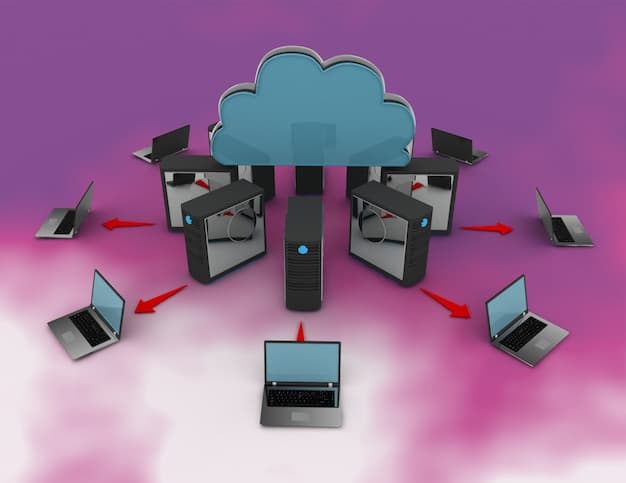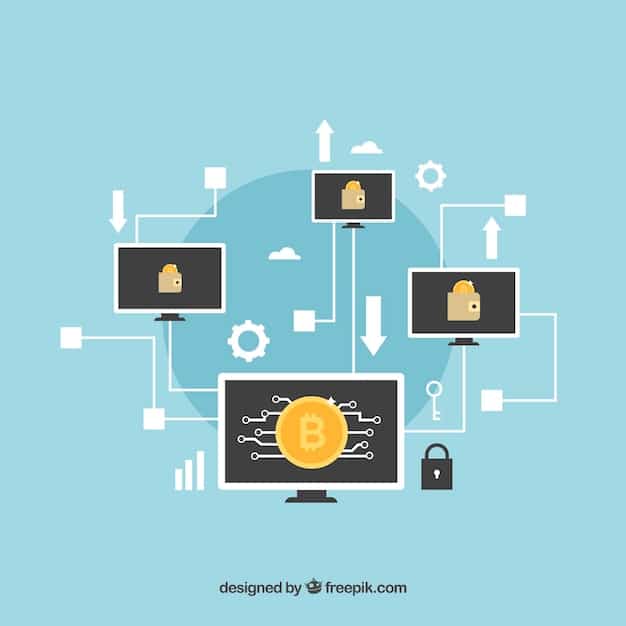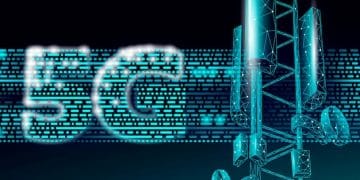Edge Computing in the US: Trends, Applications & Challenges

The rise of **edge computing** in the US is driven by the need for faster data processing, reduced latency, and enhanced security, impacting various industries and facing unique challenges in deployment and infrastructure.
The digital landscape is rapidly evolving, and at the forefront of this transformation is edge computing. In the US, this technology is experiencing significant growth, driven by the increasing demand for faster, more efficient data processing closer to the source.
The Growing Market for Edge Computing in the US
The US market for edge computing is expanding rapidly, fueled by advancements in technology and increasing demand from businesses looking to gain a competitive edge. This growth is driven by several factors, including the proliferation of IoT devices, the need for real-time data processing, and the desire to reduce latency.
Key Market Drivers
Several factors are contributing to the increased adoption of edge computing in the US. These drivers are reshaping the technological landscape and creating new opportunities for businesses and consumers alike.
- IoT Expansion: The explosion of Internet of Things (IoT) devices, from smart home appliances to industrial sensors, is generating massive amounts of data that need to be processed quickly and efficiently.
- Real-Time Processing: Many applications, such as autonomous vehicles and augmented reality, require real-time data processing to function effectively. Edge computing enables this by placing processing power closer to the data source.
- Reduced Latency: By processing data locally, edge computing reduces the latency associated with sending data to a centralized cloud server, improving response times and user experience.
Companies in the US are investing heavily in edge computing infrastructure and solutions to capitalize on these trends. This investment is expected to continue, driving further market growth in the coming years.

Key Applications of Edge Computing Across Industries
Edge computing is finding applications in a wide range of industries in the US, from manufacturing to healthcare. Its ability to provide real-time data processing and reduced latency is making it an essential technology for many businesses.
Manufacturing
In manufacturing, edge computing is being used to monitor production lines, detect defects, and optimize processes. This allows manufacturers to improve efficiency, reduce costs, and enhance product quality.
For instance, sensors on machines can send data to edge servers, which analyze the data in real-time to identify potential problems. This can prevent downtime and ensure that production runs smoothly.
Healthcare
Edge computing also has significant applications in healthcare. Remote patient monitoring, telemedicine, and smart hospitals are all benefiting from the technology’s ability to process data quickly and securely at the point of care.
For example, wearable devices can transmit patient data to edge servers, which can analyze the data and alert healthcare providers to any abnormalities. This can improve patient outcomes and reduce the cost of healthcare.
Retail
Retailers are leveraging edge computing to enhance customer experience and optimize operations. From personalized shopping recommendations to inventory management, edge computing is transforming the retail landscape.
- Personalized Shopping: Edge computing allows retailers to analyze customer behavior in real-time and provide personalized shopping recommendations, increasing sales and customer satisfaction.
- Inventory Management: Edge computing can be used to track inventory levels and optimize supply chains, reducing waste and improving efficiency.
- Enhanced Security: By processing data locally, edge computing can enhance security and protect sensitive customer information.
These examples highlight the diverse applications of edge computing in the US, underscoring its potential to transform various industries and improve the way we live and work.
Infrastructure Challenges in Edge Computing Deployment
While edge computing offers numerous benefits, deploying and managing edge infrastructure presents several challenges. These challenges include the need for distributed infrastructure, security concerns, and the complexity of managing a large number of edge devices.
Distributed Infrastructure
Edge computing requires a distributed infrastructure with servers and devices located closer to the data source. This can be challenging to set up and manage, especially in remote or underserved areas.
Furthermore, the cost of deploying and maintaining a distributed infrastructure can be significant, requiring careful planning and resource allocation.
Security Concerns
Security is a major concern in edge computing, as edge devices are often located in unsecured environments. This can make them vulnerable to cyberattacks and data breaches.

Implementing robust security measures, such as encryption and access controls, is essential to protect edge devices and the data they process.
Management Complexity
Managing a large number of edge devices can be complex and time-consuming. This requires specialized tools and expertise to monitor and maintain the devices effectively.
Automating management tasks, such as software updates and security patches, can help reduce the complexity and improve efficiency.
The Role of 5G in Advancing Edge Computing
The rollout of 5G networks in the US is playing a crucial role in advancing edge computing. 5G’s high bandwidth, low latency, and increased capacity make it an ideal technology for supporting edge computing applications.
With 5G, edge devices can transmit and receive data much faster, enabling real-time processing and improved response times. This is particularly important for applications such as autonomous vehicles and augmented reality, which require ultra-low latency.
Moreover, 5G’s increased capacity allows for a greater number of devices to be connected to the network, supporting the growing demand for IoT devices and other edge-enabled applications.
- Enhanced Data Transfer: 5G’s high bandwidth enables faster data transfer between edge devices and servers, improving performance and efficiency.
- Ultra-Low Latency: 5G’s low latency is essential for real-time applications, such as autonomous vehicles and remote surgery.
- Increased Capacity: 5G’s increased capacity supports the growing demand for IoT devices and other edge-enabled applications.
The combination of 5G and edge computing is expected to unlock new opportunities and drive innovation across various industries, transforming the way we live and work.
Edge Computing vs. Cloud Computing: A Comparative Analysis
Edge computing and cloud computing are often compared and contrasted, but they are not mutually exclusive. In fact, they can complement each other to provide a comprehensive solution for data processing and storage.
Cloud Computing
Cloud computing involves processing and storing data on remote servers, typically in large data centers. This offers several advantages, such as scalability, cost-effectiveness, and ease of management.
However, cloud computing can suffer from latency issues, especially when dealing with large amounts of data or real-time applications. This is where edge computing comes in.
Edge Computing
Edge computing, as discussed, brings processing power closer to the data source, reducing latency and improving response times. This is particularly useful for applications that require real-time data processing, such as autonomous vehicles and augmented reality.
While edge computing can complement cloud computing, it also has its limitations. Edge devices typically have less processing power and storage capacity than cloud servers, and they can be more difficult to manage.
A balanced approach, combining the strengths of both edge and cloud computing, is often the best solution for many businesses. This allows them to leverage the scalability and cost-effectiveness of the cloud while benefiting from the low latency and real-time processing capabilities of edge computing.
Future Trends in Edge Computing in the US
The future of edge computing in the US looks promising, with several trends expected to shape the market in the coming years. These trends include the increasing adoption of AI at the edge, the development of new edge computing platforms, and the expansion of edge computing into new industries.
One key trend is the integration of artificial intelligence (AI) at the edge. This involves deploying AI algorithms on edge devices to analyze data in real-time and make intelligent decisions without the need for cloud connectivity.
Another trend is the development of new edge computing platforms that simplify the deployment and management of edge infrastructure. These platforms offer features such as automated provisioning, remote monitoring, and security management.
- AI at the Edge: Integrating AI algorithms into edge devices enables real-time data analysis and intelligent decision-making.
- New Edge Computing Platforms: Emerging platforms simplify the deployment and management of edge infrastructure.
- Expansion into New Industries: Edge computing is expanding into new industries, such as agriculture and smart cities, driving further growth and innovation.
As edge computing continues to evolve, it is expected to play an increasingly important role in the digital landscape, transforming the way we live and work.
| Key Aspect | Brief Description |
|---|---|
| 🚀 Market Growth | Driven by IoT, real-time needs, & reduced latency. |
| 🏭 Applications | Manufacturing, healthcare, and retail benefit significantly. |
| 🛡️ Challenges | Infrastructure, security, and management complexity. |
| 🌐 5G Impact | Enhances data transfer, reduces latency, increases capacity. |
What is Edge Computing?
▼
Edge computing processes data near the source, reducing latency. Unlike cloud computing, which centralizes data processing in remote servers, edge computing distributes it across various locations closer to devices and users.
▼
Edge computing provides faster data processing, reduced latency, improved security by processing data locally, and enhanced reliability as it can operate independently of a central network connection.
▼
Manufacturing, healthcare, and retail are key adopters. Manufacturing uses it for real-time monitoring, healthcare for remote patient care, and retail for personalized shopping experiences and inventory management.
▼
Challenges include the need for distributed infrastructure, ensuring security across numerous edge devices, managing the complexity of a large network, and the initial cost investments for deployment.
▼
5G enhances edge computing by providing higher bandwidth, lower latency, and increased network capacity. This supports real-time data processing and allows for more devices to connect, improving the efficiency of edge applications.
Conclusion
In conclusion, the rise of edge computing in the US represents a significant shift in how data is processed and utilized across various industries. While challenges remain, the benefits of reduced latency, enhanced security, and real-time processing are driving its adoption and paving the way for future innovation.





